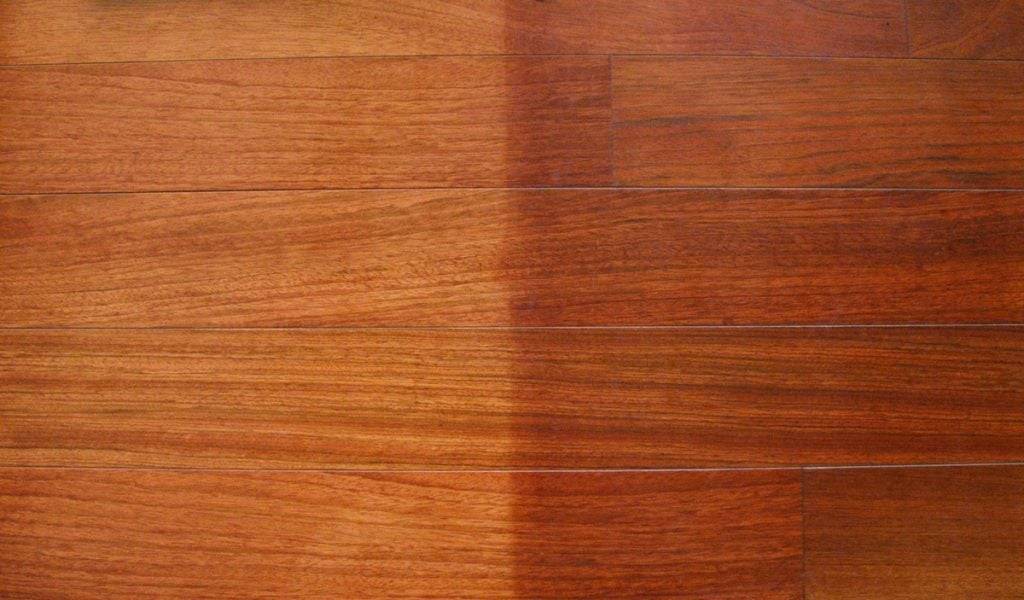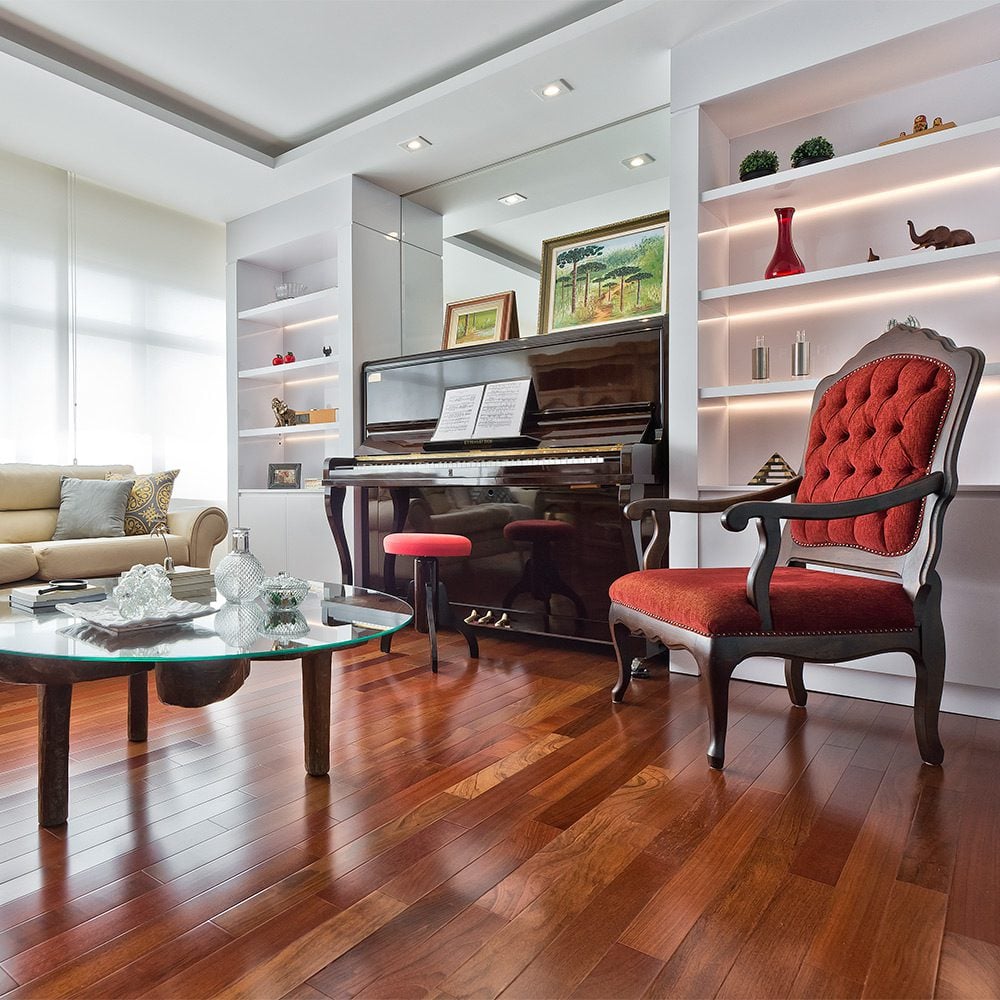Brazilian Cherry, also known as Jatoba, is an exotic wood that’s naturally quite beautiful, featuring rich tones of red, brown, and often gold. The color deepens over time due to exposure to light, which makes the wood more appealing. Its grain is typically straight, with occasional interlocking.
When it comes to staining Brazilian Cherry wood flooring, some may argue that it doesn’t necessarily need to be stained due to its natural color and beauty.
The picture below shows a Brazilian Cherry floor that had a piece of furniture on the left side. You can see the original color on the left and how the floor darkened overtime from exposure to light.
Brazilian Cherry is photosensitive like many woods so it will tend to darken and become more rich in color. Many appreciate this characteristic of the wood.

Most flooring manufacturers like AdvantageLumber.com offer Brazilian Cherry Flooring in it’s natural color and offer it in either prefinished or unfinished.
We can supply a tinted Brazilian Cherry flooring which is tinted darker to minimize the photosensitive color changing. These are typically a special order and we usually don’t recommend this option.
The reason we don’t typically recommend staining floors or ordering them tinted is when they scratch you can get scratches deep enough to scratch through the finish and stain color. This will make the scratches much more noticeable.
That said many people are still drawn to the durability of Brazilian Cherry due to it’s Janka hardness of 2,350 compared to Red Oak which is only 1,290. The hardness is a very important factor for hardwood flooring because that’s the rating that shows it’s ability to resist denting from things like high heels.
Dents in your hardwood floor lead to the finish chipping off in those spots and more sanding to get down beyond the dent. So you would be more likely to sand and refinish an oak floor opposed to Brazilian Cherry.
The durability and beauty of the Brazilian Cherry grain leads many to choose this as a flooring option but they still want to change the natural color.
There are benefits to ordering unfinished Brazilian Cherry flooring and staining and finishing yourself.
- Test multiple stain colors. You can test multiple stain colors before committing to your entire floor. Simply sand your different test swatches once you are happy with your choice.
- Retouch scratches. If your floor scratches beyond the finish and stain, it’s easier for you to touch up a spot if you know your stain color and finish. It’s near impossible to match factory stains and finishes.
- Seamless finish. When you order unfinished flooring you are committing to applying a finish yourself. This gives you a seamless floor where your finish will coat the entire floor. Prefinished floors have a micro-bevel in between each plank which can tend to trap dirt and dust. You need to clean them very good to ensure this does not build up over time.
- Trends change over time. When this happens you can refinish and stain your Brazilian Cherry flooring a more trendy color. Grey tones are popular now but probably won’t be 10 years from now.
Generally Brazilian Cherry takes stains well, but due to its dense and oily nature, it requires a bit of extra care during application. The options are limitless, but typically, you might want to choose a stain that complements its natural reddish-brown color, such as:
- Natural Color: It allows the wood to darken naturally with exposure to light over time, enhancing its inherent beauty. The natural color is what most homeowners choose and they accent the flooring with wall and furniture colors.
- Mahogany or Cherry: These stains can help bring out the natural reddish tones in the wood.
- Walnut or Dark Oak: For a darker, more traditional look.
- White Wash: For a lighter, brighter look. Solid colors pigments might not take to Brazilian Cherry as well due to it’s density and oily characteristics.
- Custom Stains: Mixing different stains can achieve a custom color tailored to your preference.
Whatever you choose if you go with your own stain and finish option order a box of unfinished flooring and test your different stain and finish options first.
Finishes are the top coat that helps protect to wood as well as stain color if you do decide to stain your floors.
Brazilian Cherry Finish Options
As for finish options, there are mainly three types of finishes commonly used for hardwood flooring:
- Polyurethane (Oil-Based and Water-Based): Polyurethane finishes provide a hard, durable layer of protection for your floor. Oil-based polyurethane imparts a slight amber tone to the wood, which can help bring out its natural color, while water-based polyurethane remains clear and can keep the wood closer to its natural, unstained color. Oil based is typically a more durable finish but emits more fumes during application and drying.
- Hardwax Oil Finish: This finish soaks into the wood rather than sitting on top of it, giving the wood a natural, matte look. It’s easy to repair and touch up but requires more regular maintenance.
- Aluminum Oxide Finish: This is one of the most durable finishes, often used in prefinished hardwood flooring. It offers excellent protection but can be difficult to refinish when it starts to wear out.
Each finish has its pros and cons, and the right one for you would depend on the level of durability you need, the look you want to achieve, and the amount of maintenance you’re willing to do.
